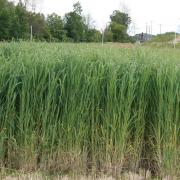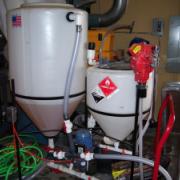
Interested in feedstock crops for biofuel energy production, but don’t know where to start? Learn about harvesting energy from sugar, starch, fiber, residues, oil and wood products.
|
|
| Sweet sorghum. Photo: Dennis Pennington, Bioenergy Educator, Michigan State University. |
Contents
- Introduction
- Sugar and Starch Crops
- Fiber and Grass Cellulosic Crops
- Oil Crops
- Crop Residues, Manures and Organic Wastes
- Wood Products
Introduction
Biomass feedstocks for energy production can result from plants grown directly for energy or from plant parts, residues, processing wastes, and materials from animal and human activities. The U.S. Department of Energy conducted an assessment of these feedstocks in 2005, (“Biomass as Feedstocks for a Bioenergy and Bioproducts Industry: The Technical Feasibility of a Billion Ton Annual Supply”) and concluded that over 1 billion tons of agricultural and forestry-related biomass could sustainably be collected and delivered to biorefineries. Feedstocks can be classified by categories of plants or residues, by the energy products they produce, or in other ways. For discussion purposes, the following categorization of feedstocks will be used: sugars/starches, fibers/grasses, oil, crop residues, manures and organic wastes, and wood and woody biomass.
|
|
|
Sugar cane a source of ethanol. Photo: Zane R. Helsel, Extension Specialist in Agricultural Energy, Rutgers University.
|
Sugar and Starch Crops
Many of the sugar and starch crops that are candidates to produce biofuels are those currently being used for grains for feed and food or for sugars for sweeteners. Root and tuber starches are typically used as food staples throughout the world. These crops and their specific products can easily be converted, via traditional fermentation methods, to ethanol and similar alcohols for use in transportation and other fuels.
The specific challenges with most of these crops will be the competition for food and the need for genetic, production, and processing modifications to enhance energy production in a sustainable way.
Fiber, and Grass Cellulosic Crops
 |
 |
|
Switchgrass. Photo: Dennis Pennington, Bioenergy Educator, Michigan State University.
|
Biomass cubes. Photo: Dennis Pennington, Bioenergy Educator, Michigan State University. |
Many of the grass and related crops that have been grown for centuries as hay and pasture for livestock feed or for soil conservation may be used as energy crops. Such crops are generally higher in fiber (cellulose, hemicellulose, lignin) and lower in carbohydrates, proteins, and oils. These crops can be converted into energy by a variety of methods including direct combustion for heat and/or power, cellulosic conversion to ethanol, thermochemical processes for fuel supplements, or anaerobic digestion for methane.
Oil Crops
While many crops produce at least a small amount of plant oils, a number of crops produce 15% to 50%+ oil. Oil can be extracted by crushing the seed and squeezing the oil out. The oil is transesterified to make biodiesel. Oil crops can also be converted into high-value biochemicals and biomaterials as alternatives to petroleum-based substances, which in turn reduces the use of fossil fuels.
 |
 |
 |
|
Sunflowers. Photo: Dennis Pennington, Bioenergy Educator, Michigan State University.
|
A 4-ton per day electric oilseed press. Photo: Joel Schumacher, Associate Specialist, Agricultural Economics, Montana State University.
|
Biodiesel processor: 60 gallons per batch. Photo: Joel Schumacher, Associate Specialist, Agricultural Economics, Montana State University.
|
Crop Residues, Manures, and Organic Wastes
When grain, sugar, starch, or oil crops are harvested for feed and food parts, significant biomass residues remain. Corn stover, corn cobs, wheat, and small grain straw are abundant crop residues that can be converted to renewable fuels. A key challenge with removing crop residues is sustainably managing the crop production system. Typically, crop residues are returned to the soil to enhance soil organic matter content and for soil and water conservation purposes. A great deal of research is being conducted to determine the impacts of stover removal on sustainability of crop production, effects on ecosystem services, and diversity of insects, vertebrates, and microbes.
 |
 |
|
Manure feedstock. Photo: SharpeShoot.
|
Anaerobic digester in Charlotte, VT. Photo: Caragh Fitzgerald, University of Maine
|
Manures are a product of plant digestion by livestock. In addition to their typical land application for nutrient value, anaerobic digestion methods have been employed for years to convert these and other organic wastes to methane and related gases. Methane can in turn be used directly for combustion heat, fueling gas turbines, or further cleaned to supplement natural gas.
Food processing and municipal wastes including restaurant grease, leaves, grass clippings, and other yard wastes are found in substantial amounts in metropolitan areas and can be collected and converted to energy by a variety of processes.
 |
|
Hybrid poplar. Photo: Dennis Pennington, Bioenergy Educator, Michigan State University.
|
Wood Products
Trees and their related products have been used for centuries as a direct combustion source for heating and cooking. These wood products, when dry, have a heating value about two-thirds that of coal and about 10% higher than herbaceous plant biomass. Wood and its products have also been utilized as the fuel source for gasification and cellulosic conversion to ethanol. While any wood source can typically be used, various research efforts have been under way to establish so-called “energy forests” or “wood energy farms.”
- Woody Crops
- Hybrid Poplar
- Willow Shrub
Contributors to This Article
Author
- Zane Helsel, Rutgers University
Peer Reviewers
- Cole Gustafson, North Dakota State University
- Dennis Pennington, Michigan State University Extension, Hickory Corners, MI


